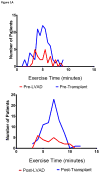Changes in cardiopulmonary exercise testing parameters following continuous flow left ventricular assist device implantation and heart transplantation
- PMID: 24893345
- PMCID: PMC4122658
- DOI: 10.1016/j.cardfail.2014.05.008
Changes in cardiopulmonary exercise testing parameters following continuous flow left ventricular assist device implantation and heart transplantation
Abstract
Background: Reduced exercise tolerance from impaired cardiac output is an important criterion for left ventricular assist device (LVAD) implantation. However, little is known about how exercise capacity changes after LVAD and how changes compare with patients undergoing heart transplantation.
Methods and results: We compared changes in cardiopulmonary exercise testing performed pre- and postoperatively in patients who underwent HeartMate II LVAD implantation (n = 25) and heart transplantation (n = 74) at the Mayo Clinic in Rochester, Minnesota, between 2007 and 2012. Preoperatively, patients undergoing LVAD and transplant had markedly reduced exercise time (mean 5.1 minutes [45% predicted] and 5.0 minutes [44% predicted], respectively), low peak oxygen consumption (VO2; mean 11.5 mL · kg · min [43% predicted] and 11.9 mL · kg · min [38% predicted]), and abnormal ventilatory gas exchange (ratio of minute ventilation to carbon dioxide production [VE/VCO2] nadir 39.4 and 37.4). After LVAD and transplant, there were similar improvements in exercise time (mean Δ +1.2 vs. 1.7 minutes, respectively, P = .27) and VE/VCO2 nadir (mean Δ -3.7 vs. -4.2, P = .74). However, peak VO2 increased posttransplant but did not change post-LVAD (mean Δ +5.4 vs. +0.9 mL · kg · min, respectively, P < .001). Most patients (72%) had a peak VO2 < 14 mL · kg · min post-LVAD.
Conclusions: Although improvements in exercise capacity and gas exchange are seen after LVAD and heart transplant, peak VO2 doesn't improve post-LVAD and remains markedly abnormal in most patients.
Keywords: Exercise capacity; heart transplantation; left ventricular assist device.
Copyright © 2014 Elsevier Inc. All rights reserved.
Figures



References
-
- Francis DP, Shamim W, Davies LC, Piepoli MF, Ponikowski P, Anker SD, et al. Cardiopulmonary exercise testing for prognosis in chronic heart failure: continuous and independent prognostic value from VE/VCO(2)slope and peak VO(2) Eur Heart J. 2000;21:154–61. - PubMed
-
- Mancini DM, Eisen H, Kussmaul W, Mull R, Edmunds LH, Jr, Wilson JR. Value of peak exercise oxygen consumption for optimal timing of cardiac transplantation in ambulatory patients with heart failure. Circulation. 1991;83:778–86. - PubMed
-
- Mehra MR, Kobashigawa J, Starling R, Russell S, Uber PA, Parameshwar J, et al. Listing criteria for heart transplantation: International Society for Heart and Lung Transplantation guidelines for the care of cardiac transplant candidates--2006. J Heart Lung Transplant. 2006;25:1024–42. - PubMed
-
- Slaughter MS, Rogers JG, Milano CA, Russell SD, Conte JV, Feldman D, et al. Advanced heart failure treated with continuous-flow left ventricular assist device. N Engl J Med. 2009;361:2241–51. - PubMed
-
- de Jonge N, Kirkels H, Lahpor JR, Klopping C, Hulzebos EJ, de la Riviere AB, et al. Exercise performance in patients with end-stage heart failure after implantation of a left ventricular assist device and after heart transplantation: an outlook for permanent assisting? J Am Coll Cardiol. 2001;37:1794–9. - PubMed
Publication types
MeSH terms
Grants and funding
LinkOut - more resources
Full Text Sources
Other Literature Sources
Medical

